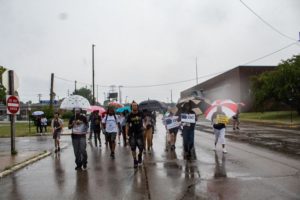In many ways, Russia’s aggression against Ukraine has resurfaced our global nuclear history. Fighting continues near nuclear power plants, including Chernobyl, the site of one of the largest nuclear energy accidents in history, invoking fear of their accidental or intentional weaponization. Russia’s placement of its nuclear weapon arsenal on high alert has unearthed anxieties and memories of the Cold War.
As governments across the world consider their own roles in lessening the risk of nuclear war, the United States cannot excuse itself. We can (and should) talk about stemming a future nuclear impact, but equally important is reckoning with our past. Not only is this reckoning a stark reminder of the dangers of nuclear weapons, but it is also a matter of justice.
Between 1946 and 1958, the U.S. nuclear testing program drenched the Marshall Islands with enough nuclear firepower to equal the energy yield of 7,000 Hiroshima bombs. Cancer rates have doubled in some places, displaced peoplehave waited decades to return to their homes, and radiation still plagues the land and waters of this Pacific-island nation.
The U.S. must prioritize the restoration of these islands and the resettlement of its people as a matter of human rights and environmental justice. We are among the few independent researchers who have studied the radiological conditions on these islands. We call on our government to commit to the kind of research program that will help to uncover the full scope of the existing contamination and how best to mitigate it. What the U.S. has done so far is simply not enough, especially as the Marshall Islands are still a close American ally. We owe them that much.
The weapons tests most gravely affected four atolls in the north of the nation: Bikini, Enewetak, Rongelap and Utirik. Testing imposed substantial radiation on these islands, endangering human and other life. In the first two cases, members of the U.S. military resettled communities prior to testing that took place on those atolls, while people on Rongelap and Utirik left after fallout from tests conducted on Bikini, such as the infamous Bravo test, reached them. Today, only Enewetak and Utirik have substantial permanent populations (even while radioactivity remains close at hand for Enewetak residents), while refugees from Bikini and Rongelap, scattered across Majuro, Kili and other islands, in addition to the U.S., have waited for decades to return to their homes.
But the nuclear story of the Marshall Islands is not just one of bygone actions. If the U.S. doesn’t better manage this situation, we could have another radioactive incident on our hands. The structural integrity of the Runit Dome, a concrete shell covering over 100,000 cubic yards of nuclear waste on an island of Enewetak Atoll, is at risk because of rising sea levels. Leakage from the dome—already occurring—is likely to increase and higher tides threaten to break the structure open in the coming decades.
To better understand the effect of nuclear testing on the islands, scientists from the Department of Energy have conducted a wide range of studies, most often on environmental contamination. Members of the military have taken action based on these findings, most notably cleaning up parts of Enewetak Atoll. However, we believe that the DOE’s work has missed critical pieces of the puzzle. For example, its scientists have consistently relied upon simulations rather than direct values of background gamma radiation, the simplest of the measurements one can make. Such a failure has contributed to the mistrust by the Marshallese towards the DOE and its findings, which was borne out of the fact that it was the department’s predecessor, the Atomic Energy Commission, that harmed them in the first place.
We are a member (Rapaport) and the director (Nikolić Hughes) of Columbia University’s K=1 Project, Center for Nuclear Studies. For several years now, our group has gone to the Marshall Islands to research the fallout of this nuclear testing. We have published our findings to ensure that independent, reliable information exists to advise Marshallese communities and leaders so that they can help chart a path forward.
Considerable contamination remains. On islands such as Bikini, the average background gamma radiation is double the maximum value stipulated by an agreement between the governments of the Marshall Islands and United States. This is even without taking into account other pathways that could lead to radiation exposure for the Marshallese. Moreover, our findings, based on gathered data, run contrary to the DOE’s, which rely on simulations that predict far lower radiation levels.
One conclusion from our work is clear: absent a renewed effort to clean radiation from Bikini, it does not seem likely that people forced from their homes will be able to safely return until the radiation naturally diminishes. This is a process that could take decades if not thousands of years. For Rongelap, further research is needed to understand the large amount of background gamma radiation on one of the northern islands, called Naen, as well as the presence of plutonium isotopes in the soil. Although Rongelap was not used as a testing site, it may be that cleanup efforts will be needed there as well, given its proximity to the detonations.
But, beyond plutonium and uranium, what other radioisotopes are at play here? One is strontium-90, which can cause cancer in bones and bone marrow, as well as leukemia. It has long been a source of health concerns at other sites of nuclear disasters like Chernobyl and Fukushima. Despite international research interest, U.S. government scientists have largely ignored the effects of strontium-90 in the Marshall Islands. The DOE’s recent report to Congress, for example, mentioned strontium-90 only once. Their recently published data are similarly lacking in an examination of this dangerous nuclear isotope.
In a recent study, we tested sediment from two bomb craters in the northern Marshall Islands, and found consistently high values of strontium-90. Though the presence of this radioisotope in sediment does not neatly translate into contamination in soil or food, the finding does suggest the possibility of danger to ecosystems and people.
The scientific community needs to reexamine the general dismissal of strontium-90, given our findings. More than that, we need a full picture of the extant contamination on these islands, which will require categorical, regularly updated surveys beyond those that have been conducted by the U.S. government. A full understanding of potential dangers to humans, plants and animals would be a first step toward alleviating health impacts and resettling people following appropriate measures.
Unfortunately, a commitment from the United States to both ends of this equation—research and action—does not exist. We call on the federal government to do what it did in the 1970s in Enewetak Atoll. This atoll, home to hundreds of people, was where scientists first tested the hydrogen bomb in 1952. The U.S.-led cleanup was successful; contamination levels in parts of the atoll are now largely below international health guidelines.
Similar success is possible elsewhere in the Marshall Islands. Here’s a playbook for how this could happen. Congress should appropriate funds, and a research agency should initiate a call for proposals to fund independent research (through an agency like the NSF) with three aims:
(1) to further understand the current radiological conditions on Enewetak, Rongelap and elsewhere;
(2) to explore innovations for future cleanup activity on Bikini and possibly elsewhere; researchers and policy makers should look to other nuclear cleanups for methods and technologies that could be employed in the Marshall Islands;
(3) to train Marshallese scientists, such as those working with the nation’s National Nuclear Commission. This point is particularly critical in rebuilding the trust in science and scientists that the U.S. lost in conducting the testing in the first place.
On top of that, we need to modernize cleanup protocols first written in the 1970s to take into consideration the complexity of the radioactive waste involved and the enormous progress in technology developments that has been achieved some 50 years later.
Wherever nuclear weapons have been used, lives were irrevocably altered. By using the collective work of dozens of researchers, rather than a small group of scientists from the DOE, the world will benefit. Given that other countries engaged in nuclear testing—whether in other Pacific islands or elsewhere—what the U.S. learns about the Marshall Islands can inform remediation efforts the world over. The Marshallese people and other affected communities have been telling us for decades just how dangerous nuclear weapons are. Let’s acknowledge and address their sacrifices and heed their warning before it is too late.




